#Mainz-pattern
Explore tagged Tumblr posts
Photo
sawds is my new favorite word and this is my new favorite post, thank you

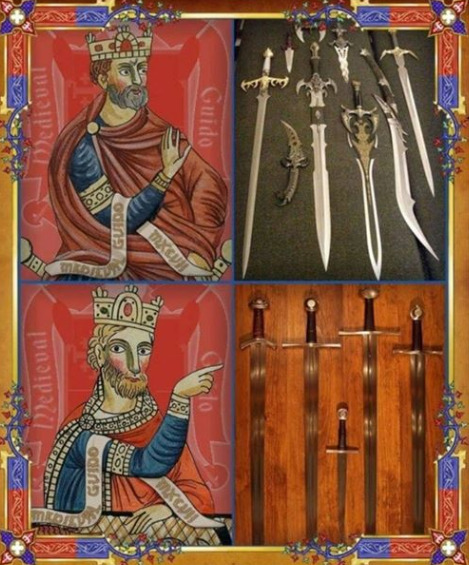
look. look at this beautiful sword meme. i’m going to cry
#swords#world history#sword#Celtic swords#Xiphoi#Mainz-pattern#shortsword#dagger#Dussack#cutlass#Zweihander#broadsword#rapier#I wanted to list every sword featured but I'm too tired for that shit#i'm sorry#I'm lazy lol
163K notes
·
View notes
Text


Sassanid helmet (6th-7th C. CE) & Luristan helmet (6th-9th C. BCE)
"The helmet housed at the Römisch Germanisches Museum in Mainz, Germany (Inv. O. 38823; Fig. 26) is dated to the late 6th-early 7th century CE. Discovered in Iran’s Amlash region, this helmet was built of bronze, silver and Iron. The Varanga “feather” (?) and/or “scale” pattern (?) is again evident as would be expected of late Sasanian helmets from the empire’s Western regions. The band enclosing the bottom area of the helmet is also decorated in the same Varanga/scale design. At the front of this area is a rectangle that has within it two vertical “sine wave” graphics. At the bottom edge of the rim can be seen punched holes, along with some cracks.
Unique in the case of this helmet is a crescent moon decoration like the one seen on Figure 25 cited previously. Atop the rectangle with the two “sine wave” designs on the helmet from Mainz is an upright crescent motif apparently based on a much earlier tradition; this is strikingly similar to the much more ancient 9th-7th century BCE one-piece domed bronze helmet (possibly Kassite in origin) excavated in Luristan (Fig. 26). At the back of the Luristan helmet is a repoussé hook and dot pattern, with a notched band of flecked triangles appearing along the border.38 The frontal decoration attached on this helmet consists of opposing mythological beast heads with a crescent ornament atop the figures. Interestingly, the Luristan helmet’s crescent motif appears in the same upright orientation as the Sasanian helmet suggesting a possible design motif spanning over 1000 years (Fig. 26)."
-Farrokh, K., Karamian, Gh., Kubic, A., & Oshterinani, M.T. (2017). An Examination of Parthian and Sasanian Military Helmets. In “Crowns, hats, turbans and helmets: Headgear in Iranian history volume I” (K. Maksymiuk & Gh. Karamian, Eds.), Siedlce University & Tehran Azad University, pp.121-163.
21 notes
·
View notes
Text
PR idea - "Backup Research"
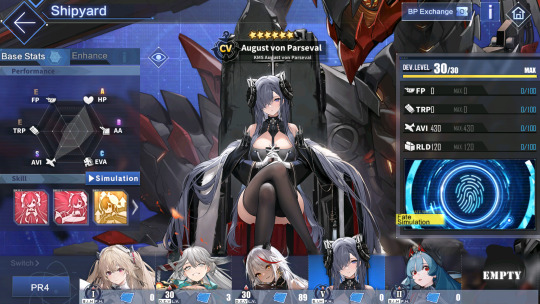
I can't be the only one bothered by the fact that we've only had 5 PRs since PR3, right?
There's this ugly empty plinth where a 6th ship should go but we have 5 empty pedestals. And I hate it.
So here's five ships from World of Warships that could be added in a single update and could fill those positions, with some prefacing. The most important thing you have to know about this is that no PR in Azur Lane is below Tier 8 in World of Warships. We have Tier 8, 9 and 10, but no Tier 6 or Tier 7. However, there are multiple very good made-up ships from those tiers that could be added as a cheap, Elite-rarity PR to fill the holes. Hence the name I give this idea - Backup Research, beacuse none of these are heavy hitters. They'd be more support shipgirls meant to make the existing PRs much stronger.
I am not going to say "X ship sould be PR3, Y ship should be PR4." I'm just going to select 5 ships.
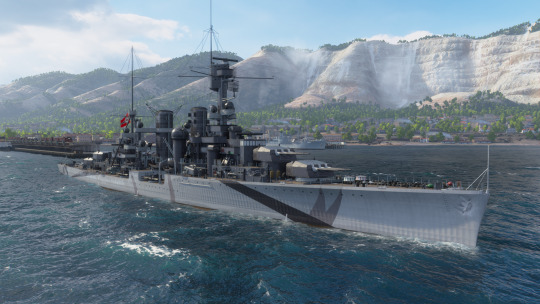
Weimar, a Tier 7 German light cruiser.
She is, effectively, a mini-Mainz. She reloads a whole 2 seconds slower than Mainz at 8 seconds, and has a depressing 14km of range - Helena has more range, and she already comes short.
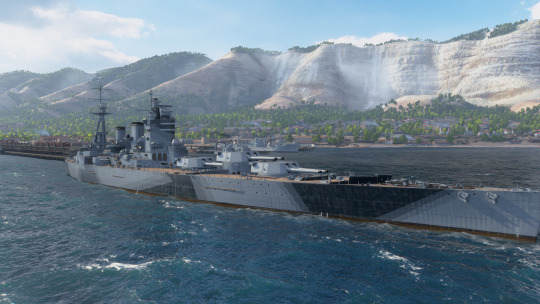
HMS Collingwood
An alternate design on the HMS Nelson and HMS Rodney that swaps their triple 406mm batteries with dual 419mm batteries. She would be a hard-hitting, yet incredibly weak and slow version of the Nelson - just like in WoWs.
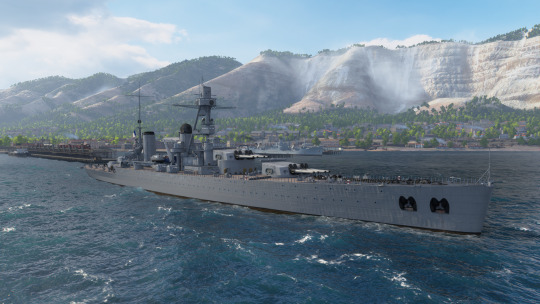
MNF Touloun
A Tier 7 version of Brest, I am making her Vichya simply so they get some Large Cruiser. For being a Tier 7 version of a kind of ship that only exists above Tier 8, she's not half bad. Two quadruple 305mm turrets that reload every 28 seconds.
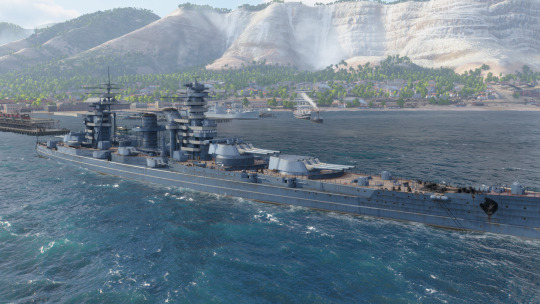
Sinop
One of the funniest battleships of Tier 7, there are not many warships at this tier with 406mm main guns. Sinop delivers, with 9 406mm cannons that reload every 33 seconds - she has artificially increased levels of accuracy at short range, in exchange of much greater dispersionat long range - like most Soviet battleships, the "shotgun" dispersion pattern (except Slava and AL Sovetskaya Rossiya).
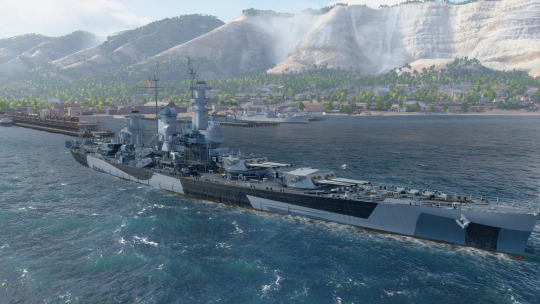
USS Florida
On the opposite spectrum of "funniest battleships at T7" (not because she's unfunny, but because of her approach) there's Florida.
Just like her namesake, this battleship is bizarre. They slapped quadruple 356mm turrets on the hull of the North Carolina and called it a day, essentially, making her honestly a very unique and not half-bad looking warship. She has a 33.5 second reload.
21 notes
·
View notes
Text
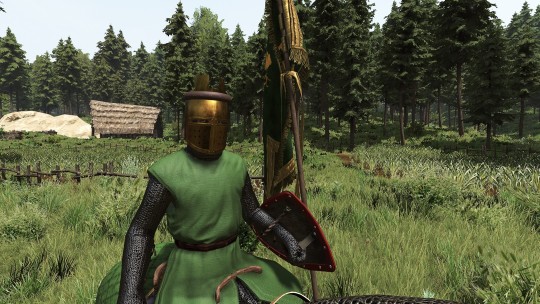
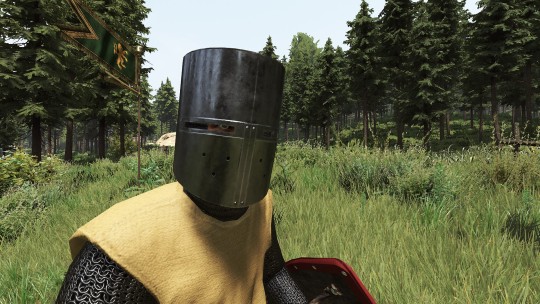

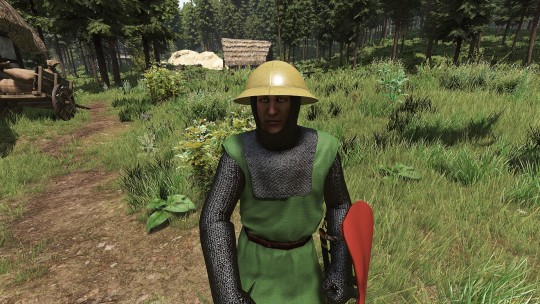

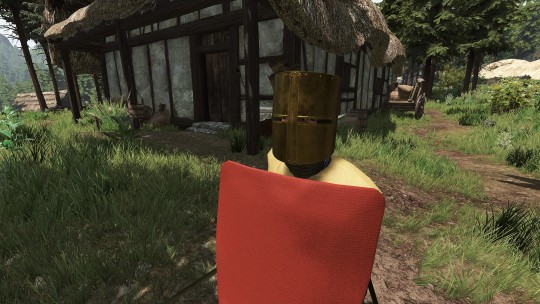
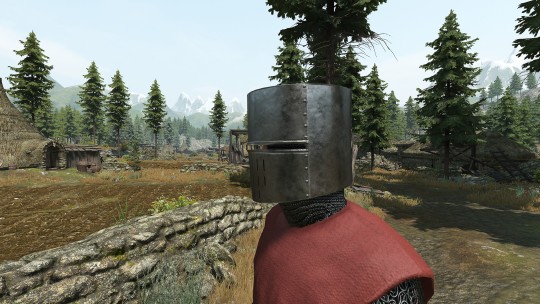
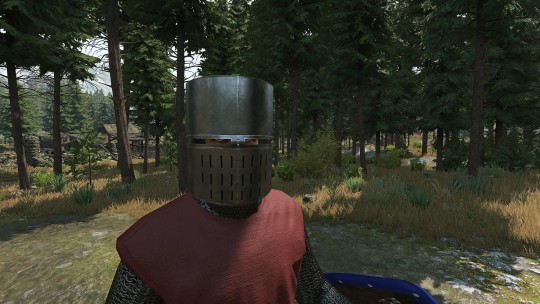
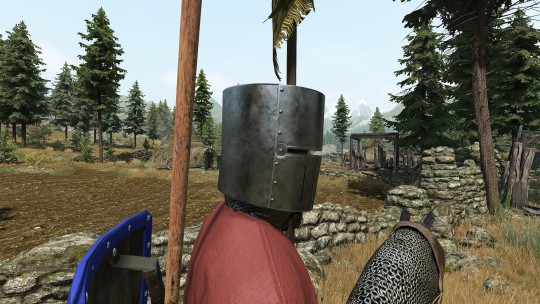

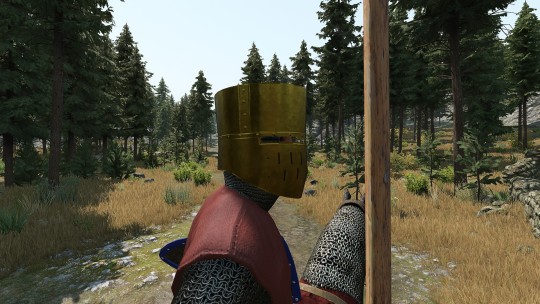
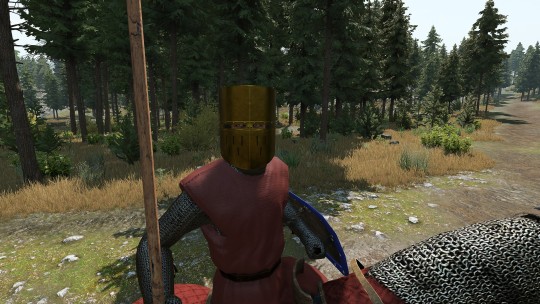

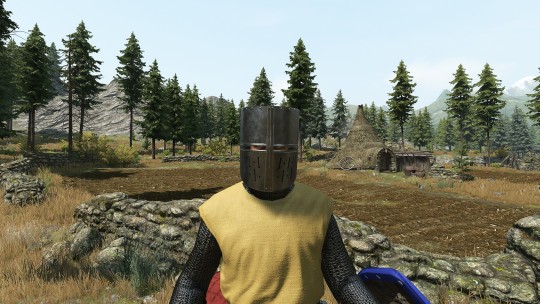
Been a while, but I got some new stuff to showcase. From top to bottom, left to right, here are the helmets and their sources: 1. A greathelm based of a German aquamanilia from lower saxony 2. A German greathelm from the german manuscript "Tristan and Isolde" (This one might be remodeled, I missed a detail on the helmet) 3. A French greathelm from a stained glass window in a Cathedral in Chartres, France (This one might also be redone.) 4. A German painted kettle helmet under a square coif from the German manuscript "Mainz Gospels" 5. A golden English Greathelm from the English Manuscript "Trinity Apocalypse" 6. An English Greathelm based off the seal of Gilbert de Clare 9th Earl of Clare 7. A German Greathelm from a seal of Nicola V de Rumigny 8. A French golden Greathelm from the manuscript "History of Outremer" 9. Last but not least, a French Greathelm from the "Maciejowski Bible".
And that is it for now. I do want to point out too that I am making shields that come in many colors/patterns based off the shield I see in manuscripts. I figured out how to make custom shields and the xml code for them. I plan on adding a lot more greathelms and helmets for lower tier troops. I will make a separate post later highlighting this development. Of course not everything is final, I will improve assets if needed or to correct any mistakes in terms of accuracy.
Sources/Credits:
Dr. Pavel Alekseychik, Natural Resources Institute Finland aka Medieval Advisor (specifically for the seal of Gilbert de Clare 9th Earl of Clare)
Manuscript Miniatures: https://manuscriptminiatures.com/ (a lot of the manuscripts/aquamanilia I use as a reference are from this website)
"Arms and Armors of the Crusading Era 1050-1350: Western Europe and the Crusader States" by David Nicole (Sketches of the Seal of Nicola V de Rumigny and French Greathelm in the Cathedral in Chartres, France)
Taleworlds Entertainment (base game models for body armor and shields)
3 notes
·
View notes
Text
FSV Mainz 2024-25 Carnival Kit Unveiled
Football kit news from Germany as the new FSV Mainz 2024-25 Carnival kit made by Jako has been unveiled. FSV Mainz 2024-25 Carnival Kit The new 2024-25 FSV Mainz Carnival kit is inspired by the Schwellkopp character ‘Karlche’ and sees the jersey made up of an all over multicoloured diamond pattern. The collar is coloured red with the Kako shirt sponsor on the right breast and the shirt sponsor…

View On WordPress
0 notes
Text
my year in reading | 2020

Marking the passing of the years has a mystical and at the same time mundane quality to me. But time is passing and to reflect upon this linearity we all are bound to does always seem more magical than anything. So, as every year, I am embracing the turning of the years and look forward to a fresh start.
The end of an old year and the beginning of a new one is always an exciting time for someone as keen on semiotics and symbolism as I am. A thin membrane, much as on Halloween, that allows us to pass through to new endeavours, if we wish to see it that way.
And I do. I don’t scoff at New Year’s Resolutions and while I know that one can resolve to change and integrate new habits at any time of the year, any Tuesday in March or Saturday in June, this brief liminal space between two years is a magical one. Anything we ascribe value to automatically becomes valuable, as it is with birthdays, full moons or anniversaries of any kind.
I would rather be someone to see the magic in these things and give them meaning beyond that which is considered “real”, “plausible”, or “rational”, than turn away and let a moment that could be something special slip away unnoticed, without giving it the chance to attach itself to something.
January began atop the Himalayan mountains for me this year, freezing down to the bone in a tent. I did carry a book with me on this trip - The Snow Leopard, quite fittingly - though I did not turn one single page (difficult in 3 pairs of gloves) and have not finished it since. So, as has been my custom these past years, I began 2020 with The Secret History, a book that could never disappoint, unlike The Starless Sea by Erin Morgenstern, that I had eagerly awaited for more than a year. You win and you lose sometimes.
In February I succumbed to reading two quite popular crime novels - The Woman in the Window and The Girl on the Train - the latter of which was a gift from an Indian friend. Sadly, I wasn’t overly excited about either of them - maybe I have outgrown crime fiction for now? I also read and loved, as always, the fifth book in Seanan McGuire’s Wayward Children series - Come Tumbling Down.
My reading month was otherwise also filled with classics such as Animal Farm, The Turn of the Screw and In Cold Blood (I have apparently not lost any interest in true crime fiction), and I also watched the Greta Gerwig adaptation of Little Women twice at the cinema. But February also saw me returning to Germany, leaving my time in India behind, prompting me to read Vivek Shanbagh’s Ghachar Ghochar and Amitav’s Ghosh Gun Island immediately upon my return.
Gun Island especially was a magical book, in some ways reminiscent of A.S. Byatt’s Possession and I absolutely adored it. I listened to Ann Patchett’s The Dutch House while sorting through all my belongings, freshly picked up from Mainz, and I quite enjoyed it. The story itself maybe not so much as the impression left behind by the tangible aliveness of the house itself. With Faber and Faber, finally, I got a sneak preview of the rather unknown Celia Fremlin and her Ghostly Stories, of which I definitely need to read more.
March was the month that would dictate the beginning of the rest of the year, when the first lockdown came upon us. R came back from India, and we managed to see each other before boarders closed. And my cousin A came to stay with us for two weeks from Milan - which would turn into almost 3 months.
Most of the month I spent ploughing through Why We Sleep by Matthew Walker, a truly eye-opening exploration and a gloriously interesting study. Luckily my sleep patterns are already quite healthy but I feel like this book could turn some people’s minds around. I also read Jane Austen’s Emma (amazingly fun and vibrant!) and continued my slow but steady reading of Agatha Christie’s collection with 4:50 from Paddington.
“April is the cruellest month,” as T. S. Eliot teaches us, and fittingly, I read the horrifying A Little Life by Hanya Yanagihara, a touching but troublesome book that had me cry a little on the balcony. I also finished three more Agatha Christie novels and started a virtual bookclub with J and C for which I read Dear Mr. M by Herman Koch and Les Fiancés de l’Hiver by Claire Dabos, which I truly loved.
In May I began tutoring, visited R in Leuven and read two disappointments: The Wych Elm by Tana French and The Bass Rock by Evie Wyld.
Even another true crime read in June, His Bloody Project, did not convince me, whereas Anita Brookner’s Look At Me sparked memories of Shirley Jackson and was thoroughly enjoyed. I listened to Frederik Bakman’s Bear Town and Us Against You at breathtaking speed, while embroidering a sweater - my best handiwork project yet. I also finished A.S. Byatt’s beautiful The Children’s Book - a magical tale, and stunningly written. A left me in June, and I missed her companionship dearly.
I worked a lot in July, and finally visited C and J ! Embroidering and just simply seeing each other again. I finished Gillespie and I, which turned out to be different to what I imagined - delightful ! I was disappointed in July by The Essex Serpent, reread A Little Princess, Die Unendliche Geschichte and Digital Minimalism.
I continued with my reading of Austen with Sense and Sensibility and listened to the wonderful The Fellowship of the Ring, which made work hours so much sweeter. Finally, I finished off the month with the final Austen - Mansfield Park, which I loved.
In August, the month of my birth, I finished The Lord of the Rings trilogy once more as well as Mythos by Stephen Fry. But more importantly, August called for freedom from working, finding an apartment in Maastricht and seeing H and J in Berlin to celebrate my birthday - with books of course.
September was a quiet reading month, what with settling in the house, at uni and making new friends. I got a sewing machine, went to Munich for an India reunion and revelled in the beautiful autumn days in the city.
I still read Bunny, The House Without Windows and Hex, amongst various reads for uni. Dinners on the balcony and an exorbitant amount of Federweißer with my roommates rounded off the month, despite the low book count.
The month of Halloween, October, called for a sixth reread of The Secret History, a New Zealand read of The Rehearsal, as well as Rest and be Thankful (disappointing somehow) and The Supper Club (surprisingly delightful). I sewed and knitted and did presentations and wrote paper proposals. I also fell up the stairs and hurt my ankle pretty badly.
The most vivid memory I have of November is that of our silent dinner. I also read two more Agatha Christies, reread Daphne DuMaurier’s classic Rebecca and Ali Smith’s Artful, and loved Public Library, also by Smith. I got tested for Corona (negatively!), began Ashtanga yoga and finished Crossing the Water - a brilliant poetry collection of Sylvia Plath.
December began with a classic, Bonjour Tristesse, and culminated with My Best Friend’s Exorcism, as well as The Stranger Beside Me. Both books I had been meaning to read for years and they exceeded my expectations. Uni stressed me slightly, pending holidays as well and as lockdown 2.0 was announced my reading brain switched itself off.
Christmas was still a joy, with the family (minus Oma) coming together, R. visiting briefly and many a book under the Christmas tree. I started reading Susan Sontag’s journals - but I will carry their brilliance into the New Year. I finished off the year sewing costumes for our medieval-plague themed NYE, J and me celebrating together, since Covid plagued us once more and prevented C from coming. But we will enter the New Year singing Total Eclipse of the Heart as always and I take with me all the positive energy I have been carrying with me for a while now.
This is also the first year that I won’t achieve my reading goal - which I set at 80 books for 2020. Instead I am finishing with a still solid 67. Overall, despite all that has been going on in the world, I cannot complain about my 2020. But let’s still hope for the best (and prepare for the worst).
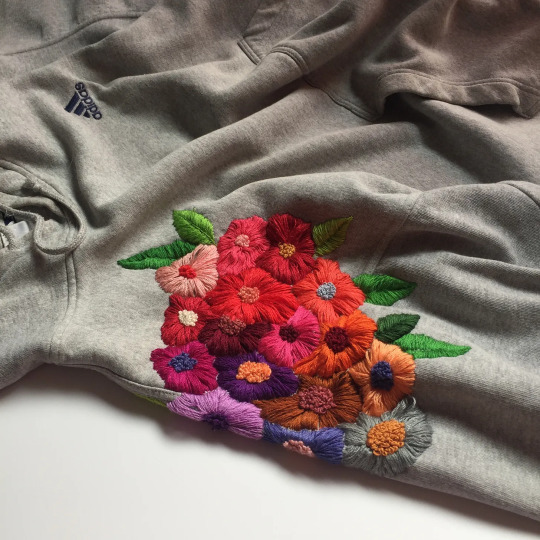
1 note
·
View note
Text

Image: Wikimedia Commons
5000-Year-Old Tablets Can Now Be Decoded By Artificial Intelligence, New Research Reveals
— M.J. Banias | November 27, 2023
A team from Martin Luther University Halle-Wittenberg, Johannes Gutenberg University Mainz, and Mainz University of Applied Sciences has unveiled an AI system capable of deciphering ancient cuneiform texts. This novel technology, leveraging 3D models, represents a significant advancement in understanding one of humanity’s earliest forms of writing.
Published in The Eurographics Association Journal, the researchers’ study focused on a set of cuneiform tablets from the Frau Professor Hilprecht Collection. These tablets primarily originate from ancient Mesopotamia, a historical region in present-day Iraq. Often referred to as the cradle of civilization, this area is where some of the earliest human societies developed. These tablets, in particular, are inscribed with a series of symbols, signs, and wedges that form the languages of the region, such as Sumerian, Assyrian, and Akkadian.
Many are over 5,000 years old and offer a glimpse into ancient civilizations, covering a wide range of topics from everyday life to legal matters.
“Everything can be found on them: from shopping lists to court rulings,” said Hubert Mara, one of the study’s authors. “The tablets provide a glimpse into mankind’s past several millennia ago. However, they are heavily weathered and thus difficult to decipher even for trained eyes.”
The team turned to AI for help.
Using a novel AI process to decode ancient cuneiform tablets, they leveraged a sophisticated AI model based on the Region-based Convolutional Neural Network (R-CNN) architecture, a specialized system designed for object recognition. The study utilized a unique dataset consisting of 3D models of 1,977 cuneiform tablets, with detailed annotations of 21,000 cuneiform signs and 4,700 wedges.
The AI’s methodology entailed a two-part pipeline: initially, a sign detector, built on a RepPoints model with a ResNet18 backbone, identified cuneiform characters on the tablets. In simple terms, the RepPoints model combs through the ResNet18 collection of images connected to the Mesopotamian languages and then combines the patterns to ‘see’ the text. This step was crucial for locating the signs accurately. Subsequently, the wedge detector, using Point R-CNN with advanced features like Feature Pyramid Network (FPN) and RoI Align, classified and predicted the wedges’ positions, which forms the basis of the cuneiform script’s fundamental elements, allowing the AI, in effect, to ‘read.’
These tools take the 3D scans of the tablets and sift through the multitude of measurements of things like the impression depth made by the stylus into the clay or the distance between the symbols and wedges. This nuanced approach enabled the AI to overcome the challenges posed by traditional 2D photographs, such as inconsistent lighting and color distractions, thus providing a more accurate analysis of the ancient texts.
Traditional research on ancient texts uses optical character recognition software (OCR), which converts scanned images or 2D photographs of the writing into machine-readable text.
“OCR usually works with photographs or scans. This is no problem for ink on paper or parchment. In the case of cuneiform tablets, however, things are more difficult because the light and the viewing angle greatly influence how well certain characters can be identified,” said co-author Ernst Stötzner.
Ancient scrolls, parchment, and old books are easy- they are a 2D medium translated into another 2D medium. Cuneiform tablets, however, are 3D, and all that depth impacts interpretation.
To address this, the research team put their AI system through an extensive training regimen, utilizing three-dimensional scans and supplemental data. A substantial portion of this data was contributed by the Mainz University of Applied Sciences, which is currently leading a significant project focused on creating 3D models of these ancient clay tablets. This enabled the AI to achieve remarkable success in accurately identifying the symbols inscribed on the tablets.
This technology not only democratizes access to these ancient records but also opens up new avenues for research, allowing for broader analysis and interpretation of historical texts. Future enhancements could extend its application to other three-dimensional scripts, such as weathered inscriptions found in cemeteries.
— MJ Banias is a journalist and podcaster who covers security and technology. He is the host of The Debrief Weekly Report and Cloak & Dagger | An OSINT Podcast.
#The Debrief#MJ Banias#5000-Year-Old Tablets#Artificial Intelligence#Martin Luther University Halle-Wittenberg#Johannes Gutenberg University Mainz#Mainz University of Applied Sciences#Eurographics Association Journal
0 notes
Note
Book of Years question - does a taipan look like a katzbalger and a makher like a messer ?
Short question, long answer - with pictures!
Just for fun, I’ve sourced almost all the images in this post from Kult of Athena to demonstrate how much visual research can be found on a single website. How accurate that visual research might be will need more work from the researcher. All of these are A-OK.
*****
The Book of Years series were originally very (excessively?) samurai-influenced, and while ebook revisions done by an older and wiser author have changed a lot of that, some aspects remain.
A wakizashi looks like a smaller version of a katana, so I imagined a taipan as being a smaller version of a taiken, which was itself inspired by the “Munich longsword” which I saw years ago in a book by Ewart Oakeshott and have admired ever since.

However I've just done a word search of all the novel files, and I’m surprised to discover that most weapons, including the taipan, aren’t described in detail. This is about as far as I ever went:
"There was a broad-bladed taipan shortsword in his hand..."
(Horse Lord)
”Broad-bladed” leaves an opening for “narrow-bladed”, just as “straight” can leave an opening for “curved”, but this is a bit like my own occasional writing advice: “If detail isn’t vital, vague will do just fine.”
However @dduane looked at it and said, “a bit less vague wouldn’t hurt once in a while.”
Not in this scene, though. That taipan’s in the principal villain’s hand, so focus is more on what he’s going to do with it - something villainous, brutal and nasty - than with how it looks.
It’s not like a katzbalger; they’re longer than I imagine a taipan to be:
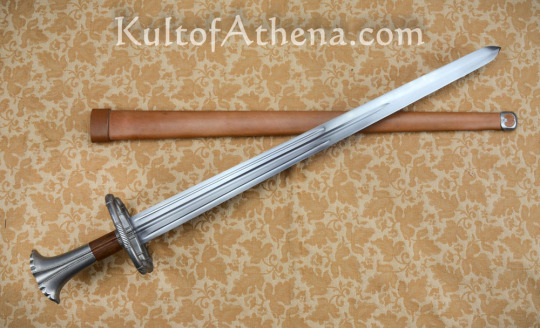
A qama or kindjal from the Caucasus is more the thing. Zaporozhian Cossack to Alban Horse Lord isn’t that much of a stretch, and may have had an influence on the “Prince Ivan” series. :->
This one’s notably long and broad...
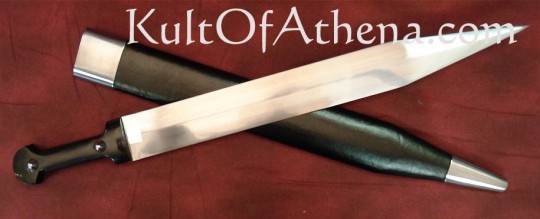
...while others are shorter, or slimmer, or curved, or all three.

The makher was created another way; there the name came first.
"Aldric took note of a diagonal belt across the man’s chest supporting a makher, the leaf-bladed shortsword favoured by the Drusalan military..."
(Dragon Lord)
I pinched that word from an Ancient Greek weapon called a makhaira which - depending on what you read and where you read it - looked like a kopis...

...or didn’t look like a kopis.

I just liked the sound of the word itself, and applied it to a weapon resembling the early (Mainz-pattern) Roman gladius.
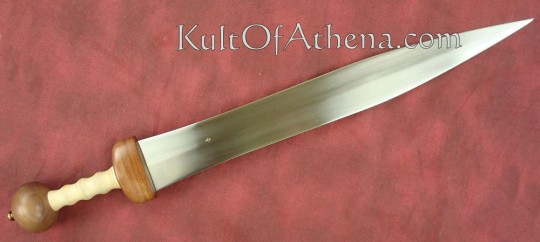
That Messer notion might come from this description:
The Drusalan’s weapon was little more than a big knife, a broad, slightly curved blade ending in a clipped point, and it looked like the bastard child of a falchion and a butcher’s cleaver.
(Demon Lord)
That was indeed inspired by combining a big Bowie knife...

...and a Messer like this repro.
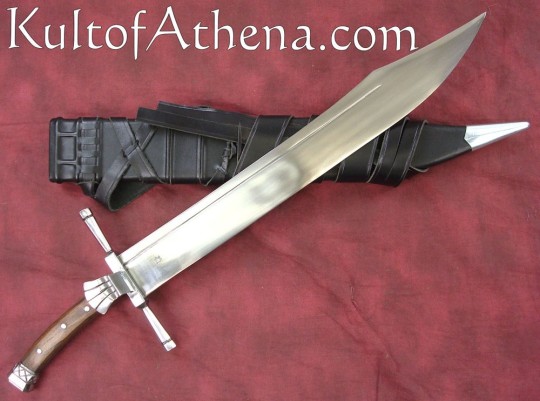
But it was never called a makher in the text, even though it’s opposed by one.
The eltmakher from “War Lord” and later IS curved, and since it's usually referred to as a "war-knife", the Kriegsmesser source is pretty obvious. This sword-hilted interpretation is even better, since it doesn’t have the distinctive Messer riveted-scales grip.
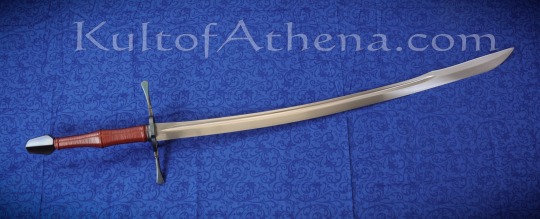
According to internal history, way back in time taikenin were also curved, with one full edge and a false edge near the point.
"(Isileth's) hilt and guards would have changed many times as style dictated, but the blade itself, one of the first to be straight and fully double-edged, had a lineage few clans could match."
(Horse Lord)
The old-style taiken I was imagining turned out to exist in real life; it was a Swiss sabre, like this repro by JT Pälikkö of Finland.

Or, even better, like this one.

“Alban swords have been straight for hundreds of years. But someone who might have, ah, personal reasons for recalling an earlier time might have a sword in the style of that time. A time when Alba was a free country. A time ‘when blades were curved and honour was straight.’ That’s what your people like to say, isn’t it?” “Not my people. Not in my hearing.” Aldric glanced at the sword. “And that’s not very curved.” (Shadow Lord)
42 notes
·
View notes
Photo

Augustus Nobilis - Mainz pattern gladius https://www.instagram.com/p/B_TGCxXjkzL/?igshid=w9yfm57s5xmt
312 notes
·
View notes
Video
youtube
Edward Vajda lecture on how Ket language structure was gradually affected by the unrelated neighboring languages. Title: “Areal features in Yeniseian grammaticalization”, a talk given for the symposium Areal patterns of grammaticalization and cross-linguistic variation in grammaticalization scenarios. Mainz, March 12-14, 2015 Recorded by Matthew Anderson, University Communications, Western Washington University.
24 notes
·
View notes
Note
What’s your headcanons for the shipgirls? Like what they like/dislike, niche hobby they’re into, their relationship with each other, etc.
ok i'll keep this to my faves only because 1. i'd be here forever otherwise and 2. that way i can make propaganda for them
rossiya is friends with almost literally anyone, she's very easy to be friends with. in part thanks to the fact that she's a big dum dum dork
chkalov develops huge crushes for literally any pretty woman she sees. she has adhd. she can spend days doing data analysis (her specialty) without noticing, she loves discovering weird patterns and stuff like that.
brünhilde has a youtube channel where she talks about the history of the many antique objects she has. she has almost a million subscribers but uploads like 9 times a year mainly because she forgets abt the channel. also she loves collecting 18th and 19th century things mainly from europe.
mainz and kuybyshev are together. kuybyshev is the emotional crutch of mainz as she has a bunch of depression-related issues and kuybyshev is like the perfect antidote to it. also she enjoys the coffee mainz makes a lot and it gives mainz a nice purpose. both enjoy watching black and white movies and sometimes brunhilde is involved.
monarch has a big platonic crush on duke of york. monarch WISHES she were as mysterious and distant yet thriving as DoY is, that way she wouldn't have to lambast herself believing nobody cares about her. she yearns to live in a cabin in the woods by herself, basically
sakawa, wakatsuki, haguro and miyuki are legit musashi's daughters. i dont have many sfw headcanons for musashi so i wont share them lol
littorio is bi with a slight preference towards women, and has a full blown estate where some sardegnan shipgirls spend entire vacations. this estate is beach-side with a private beach and stuff like that. she's a famous supermodel.
georgia and seattle are legit just besties and not in a relationship (because georgia's gf is monarch duh), and both love to travel around the world and also party a lot.
i have a few more but i cant remember them rn
15 notes
·
View notes
Photo

Teamwork Works
When it comes to building a living organism, teamwork is key. Many different molecules have to work together to make sure that the right parts grow in the right place at the right time. In the case of developing fruit flies (Drosophila), some of these components are pre-packaged in the egg ready to spring into action once it's fertilised. Some of them play a particularly important role in setting up the basic pattern of the embryo, with the head at one end and the tail at the other. These images show Drosophila egg chambers stained with fluorescent dyes that highlight various molecules involved in early embryo development. By figuring out where each molecule appears (green or red) and where they overlap (yellow), researchers can start to understand how they get located in the right place in the egg and tease out how they interact together to make an embryo.
Written by Kat Arney
Image adapted from work by Annabelle Dold, Hong Han and Niankun Liu, and colleagues
Image originally published with a Creative Commons Attribution 4.0 International (CC BY 4.0)
RNA Epigenetics, Institute of Molecular Biology, Mainz, Germany and Department of Biology, McGill University, Montréal, Québec, Canada
Published in PLOS Genetics, January 2020
You can also follow BPoD on Instagram, Twitter and Facebook
#science#biomedicine#developmental biology#embryonic development#immunofluorescence#drosophila#fruit flies#plos genetics
8 notes
·
View notes
Text
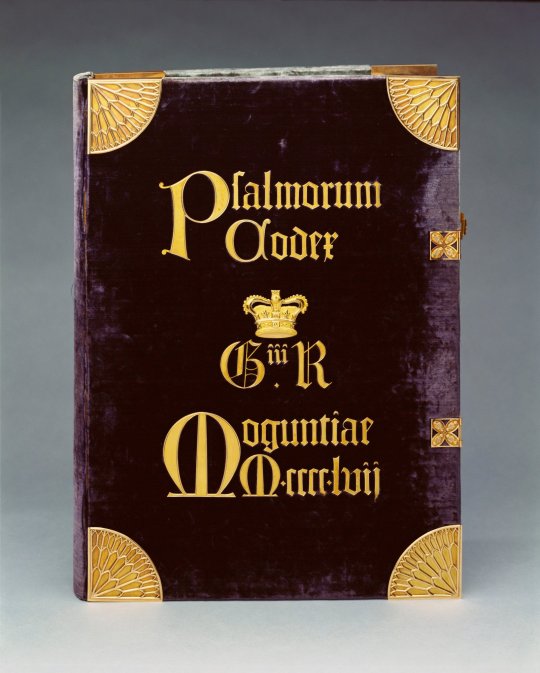




The Mainz Psalter 14 August 1457
This is one of only ten copies known of the second book to be printed by the system of movable metal type, the first being the Gutenberg Bible, printed in Mainz 1453-5. The Windsor copy is one of the six surviving 'short issues'; the Psalter was printed in two lengths, the longer ones (of 175 leaves, of which 4 copies survive) specifically for the diocese of Mainz, the shorter ones for more general use. It is also the first book known to have been printed in red and black. This was done with a single pull of the press, the type to be printed in red having been inked separately from the black and reinserted into the same forme (the locked frame holding the prepared type). This process meant that the two colours would be in perfect register, without any unsightly overlaps. The large two-colour initials (e.g. the large initial C) were printed from woodblocks by a similar method, the block for the letter being separable from the block for the surrounding pattern. By contrast, the large blue, red and black capitals (e.g. the blue E in Ecce iam noctis, f. 97v, or the red N in Nocte surgentes, f. 98r) were inscribed, as were some of the rubrics (words in red, usually instructions to the celebrant, or catchwords to help him find his way about the page). The music, and the words to accompany the music, were also added in manuscript. The scribe responsible wrote a beautifully even hand, which has been suggested as the model for the type, so closely do they correspond.
Printed in Mainz by Johann Fust and Peter Schoeffer.
Catalogue entry from Royal Treasures, A Golden Jubilee Celebration, London 2002 Provenance Monastery of St Ursula, Hildesheim; from which bought by Friedrich Wilhelm von Duve (1707-85), 1758; from whom bought by Göttingen University, 1782; by whom presented to George III, 1800 (£400 reimbursed, 1817)
1 note
·
View note
Text
Aesthetics
The theory of aesthetics can be split into three definitions.
1) a particular taste for, or approach to, what is pleasing to the senses, especially sight.
It comes from the root word “Aesthesia”: the ability to feel or perceive; being awake and able to feel senses. In this definition, it is something that appeals to the senses, and aesthetic judgement is based on perception and artistic judgement. Aesthetic choices are mostly subconscious, from what you wear to what you buy. These can influence bigger aesthetic choices like decorating your home or designing rooms in a professional setting.
2) a branch of philosophy dealing with the nature of art and beauty.
The philosophy of aesthetics deals with the bigger questions associated with aesthetics, such as: how we define art, how we define beauty, how personal taste can influence how we judge art, the standards we hold art against, why originality is so important, what defines originality as well as what defines creativity. This is very important in terms of art because these ideas help critics to identify what is art and what is copying other’s works. Under this definition is also the question of who decides what constitutes art, such as public interest in the piece, art dealers, critics and gallery owners. This can be a good and a bad thing, considering a critic’s personal taste can define the value of an art piece.
3) a particular theory or conception of beauty or art.
This definition helps us to identify what constitutes a work of art, what we can learn from these works and the value that should be placed on those works.
Some aesthetic theories are:
Representation, immitation and the concept of divine inspiration
Plato theorised that artists represented and imitated reality, in addition to the idea that artists were divinely inspired to create work. They imitate reality to appreciate the beauty in life and the world around us, however, issues with this theory arise when considering artists like Jackson Pollock - who don’t conform to naturalistic art. The divine intervention mentioned was believed because art was considered powerful, and therefore dangerous, so artists were considered to have God-like influences. (http://users.rowan.edu/~clowney/Aesthetics/philos_artists_onart/plato.htm#top)
Martin Johnson Heade, Thunderstorm at the Shore, c. 1870-1871, oil on paper mounted on canvas attached to panel 15 3/4 x 23 3/4 in. Carnegie Museum of Art, Howard N. Eavenson Memorial Fund

Expressionism
This theory says that art is the expression of inner emotions, feelings, moods and mental states of the artist, with good art effectively conveying these internal means externally.
Willem de Kooning, Woman VI, 1953, Oil on canvas

Formalism
This says that the essence of art is that of ‘significant form’; shape, colour, lines as well as other formal properties of the work. Representation, expression and other subject matter are irrelevant. This considers good art as work that elicits an “aesthetic emotion” for sensitive observers.
Donald Judd, Untitled, 1974, Stainless steel and Plexiglas, 8 x 194 1/2 x 14 in. Carnegie Museum of Art, Purchase: a gift of Mr and Mrs Charles Denby, by exchange

Communication of moral and religious ideas
The essence of art is the communication of important moral and religious values from the artist to the observer. Good art is a form of sincere communication by the artist that “infects” the observers with those important moral ideas.
Simon Bening, St. Gertrude de Nivelles, from the Hours of Cardinal Albrecht of Brandenburg (1490-1545), Archbishop and Elector of Mainz c. 1522-1523, opaque water-based paint mounted on board 7 x 5 in. Carnegie Museum of Art, Bequest of Howard A. Noble

Symbolic communication
The essence of art is the communication of important ideas and other knowledge through symbolic (non-verbal) languages. Good art communicates its meaning effectively through this non-verbal language.
Jacob Ochtervelt, Lady with Servant and Dog, c. 1671-1673, oil on canvas, 27 1/8 x 22 7/8 in. Carnegie Museum of Art, Henry Lee Mason Memorial Fund

Instrumentalism
The essence of art is its usefulness in helping us to comprehend and improve our overall life experiences. Good art is always a means to some important end.
Romare Bearden, Pittsburgh Memories, 1984, collage on board, 28 5/8 x 23 1/2 in. Carnegie Museum of Art, Gift of Mr. and Mrs. Ronald R. Davenport and Mr. and Mrs. Milton A. Washington

Institutionalism
Art is determined by status conferred upon it by the institutions of the art world not by an observable property in the artwork itself
Barry Le Va, On Corner - On Edge - On Center Shatter (Within the Series of Layered Pattern Acts), 1968-1971, twenty sheets of glass 59 x 79 in. ( 91 x 150 x 201 cm) Carnegie Mellon Art Gallery Fund

Definitions sourced from google, they have been paraphrased for clarity.
1 note
·
View note
Text
This was our first in-person session in...pffff idk probably a year, we ended up having technical difficulties and dinner so we didn't start for about two hours after all arriving, but it was kind of nice to be able to walk around and actually see everyone for a change.
At this point both Glarenthy and the Giant from before (now having been revealed as the arena champion, Utluro Mainz) have been watching the fight from their own box in the arena stands. With every foe the Party deals with Ulturo tightens his grip on his Starlight lance and grinds it into the stonework under him.
Keeping their initiative from the manticore fight, Rostam eyes up Gullivan, a bulette with a blue sheen, and notices it's got cuts and scrapes along it, he surmises that it must be fairly old and battle weary but he ends up being mostly wrong about that. Bounty, a bulette with a yellowy hue, makes the first move and leaps towards the Party, damaging most of them and knocking Dave to the ground.
Cronwer retaliates with his Shadow Blade and Vahlok wraps one of his chains around Bounty's neck to choke it while Dave slashes at it with his greatsword. Rostam gains Gullivan's attention and shirks off any attacks sent his way, keeping it from helping Bounty. Gullivan bites at Vahlok before managing to break his hold on it and burrows under the ground, creating small pitfalls in the sand as he does.
Dave spikes a totem in the ground that bolsters his allies every few seconds and gives them temporary health as the rest of the Party wails on the two beasts. Eventually Vahlok retreats after Bounty viscously bites him but he walks right into a pitfall and sinks to his waist in the sand, Bounty ceases the opportunity and leaps at him, driving Vahlok further into the sand almost killing him.
Cronwer devises a plan and uses Hypnotic Pattern to stun both of the bulettes so that the Party can get a moment deal with the injuries the two creatures have given them. With the bulettes (and Vahlok) successfully subdued by the spell, Dave runs over to pull Vahlok out of the sand and the others get as much healing done as they can, but just before they can get into position to make optimal use of the spell's effect, Rostam throws an axe at Ulturo up in the stands, dealing almost no damage through the Giant's platemail.
With his dwindling patience tested Ulturo raises his lance into the air calls forth a Moonbeam to burn at Rostam, only for it to dissipate as Crowner Counterspell's it. Ulturo's frustration flares as he leaps from his place beside the Head Priestess and joins the fray, knocking Rostam to the ground, and immediately striking at him with a series of unarmed strikes and slashes from his lance as he lays there. Dave makes the apt decision to attack Bounty before he can be shaken from his stupor, but to little effect as his blade tries to glide off of Bounty's hard scales. Vahlok pitches in and strikes Bounty with his chains and finds the bluntness of the chains to work well.
Cronwer barrages Ulturo with necrotic Magic Missiles from his staff and Bounty bites back at the barbarians assaulting him, Ulturo kicks at Rostam on the ground before he can stand up, and punches him in the gut after Rostam misses a swing against him. The Giant then moves over to Gullivan who's still dazed, picks him up by his tail and swings him like a club at Rostam before throwing the bulette and Cronwer, damaging him and knocking him to the ground.
Cronwer then visciously mocks the large shark for being used in suck a way, making it miss an attack in its embarrassment. Ulturo and Rostam trade blows back to back before he decides to throw the barbarian at Cronwer while the others finish off Bounty. Gullivan lunges at them after seeing his partner killed and keeps attacking Dave.
Crowner tries to use Heat Metal on Ulturo, hoping to make him take off his armor but it fails, Dave bites Gullivan back when suddenly a horn blows and one of the gates to the arena opens. Members of the crowd watching stand up as the fight enters and intermission, through the open gate comes a women with a platter of refreshments for the arena fighters to choose from, options being a health potion, a golden trinket, and a homebrew potion to restore spell slots.
And that's where we left off for the night.
0 notes
Photo
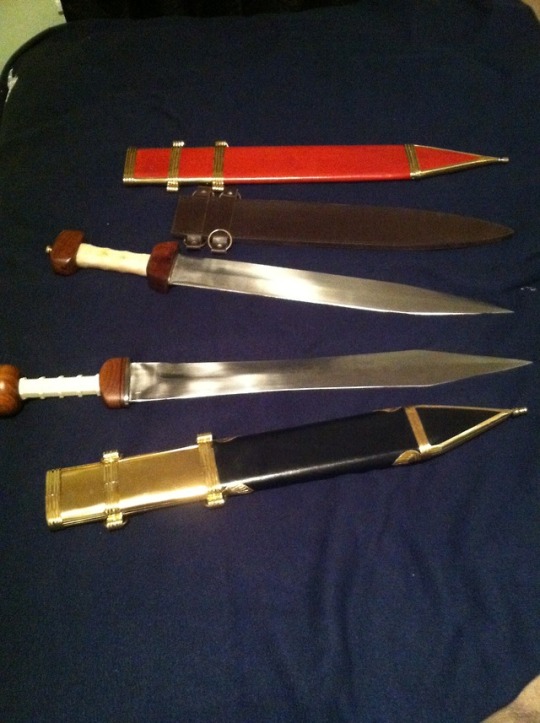
A Tale of Two Gladii --- You Don’t Always Get What You Pay For
As most of you have probably noticed I have really diversified my content lately, posting a lot more than just antique firearms, but antique arms in general such as swords, daggers, archery, armor, and other melee weapons. So recently I decided to buy some swords. Since I’m big into ancient Roman history I had to get a gladius. My first purchase was a cheap display piece, blade isn’t even sharpened, not even worth mentioning. About a year ago I purchased the “murmillo gladius” produced by Devil’s Edge, which can be found for sale at Kult of Athena for around $130. Recently, after receiving a small tax refund, I decided to use that money to upgrade, selling my older murmillo gladius to pay back student loans. I then purchased the Mainz Pattern Gladius from Windlass Steelcrafts for $215, plus another $18 for sharpening services as the blade comes unsharpened unless requested. When I got my new gladius, I was greatly disappointed.
The Devils Edge gladius is actually a nice sword for it’s price. It features a polished bone handle, a 1095 carbon steel blade which is very sharp, not razor sharp, but still quite impressive. Unlike Windlass Devil’s Edge sells their blades sharp, so no need for extra sharpening services. The sword feels nice in the hand, it’s fairly well balanced, lightweight, and easy to swing. It comes with a leather sheath. At first the sheath was too tight, making it hard to draw the sword, but it loosens up with repeated use, basically it needs to be worn in. I noticed the sword fits in the scabbard from my cheap display sword, so I mostly keep it in that rather than the leather sheath. The sword seems a little rough around the edges, but otherwise not bad for $130.

Now onto the Windlass Mainz Gladius. At first glance this looks like a great sword. Finish is nice, it’s very decorative, I love the look of the Mainz pattern blade. But on more scrupulous inspection, this sword has some major problems. This sword is advertised as having a “faux ivory grip”. Now I understand that Windlass can’t use real ivory, but I did not expect “faux ivory” to be plastic. I was expecting something more like polished and bleached bone like other gladius makers use in place of ivory. Furthermore, the “brass” decorative mountings on the scabbard I suspect are plastic. When I was purchasing something for $230 I was not expecting any plastic to be on it. That’s pretty pathetic. The leather sheath by Devil’s Edge is much more tasteful. Speaking of the scabbard, the sword doesn’t fit right. It’s so loose that it will easily fall out if tipped slightly. I paid $18 for extra sharpening services, but the sword is not sharp. It barely has an edge. Might be good for cutting butter or cheese, but not barbarians. I guess I could sharpen it myself but I paid for sharpening services, so why should I have to? Finally the handle is very uncomfortable, mostly caused by the squared ridges along it’s length. Swinging it causes abrasions which feels like it will blister, and my hands are very delicate from washing them 100 times a day (I work in healthcare). It’s balance is better than the Devil’s Edge sword, but not that much better. Overall the smooth handle of the Devil’s Edge is a big plus and is much better than Windlass’ rough plastic handle.
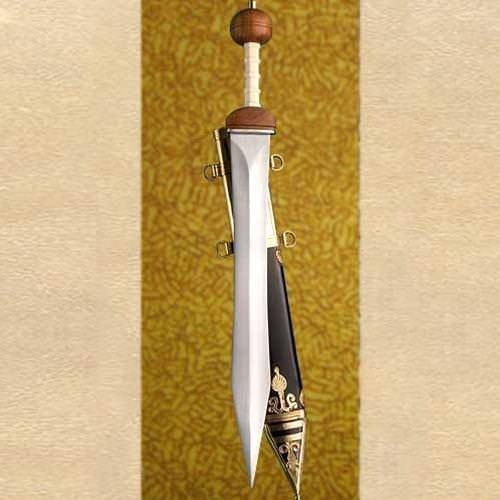
So I’m disappointed. I should have sent the sword back with complaints, but I didn’t. Soon I’m going to get around to selling it on ebay while keeping the Devil’s Edge Gladius.
Now I do have to mention one caveat. Apparently Devil’s Edge has had issues with the heat treating and hardening of their blades, as demonstrated in Skallagrim’s review of the Devil’s Edge Xiphos
youtube
Now supposedly they’ve fixed this problem. Plus I haven’t seen any similar complaints with their gladius in other reviews. I haven’t done any torture tests to see if the blade is strong. Regardless I still like the Devil’s Edge better.
When I pay off my student loans I’m going to buy a Mainz Pattern Gladius from Albion Swords. Only costs around $750. Devil’s Edge compared to Albion is like Boone’s Farm compared to Dom Perignon.
113 notes
·
View notes